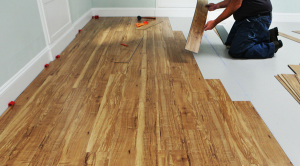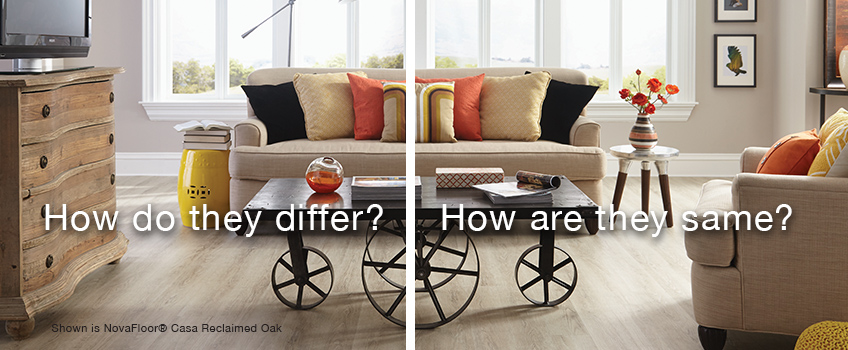 In LVT flooring, the world is divided into floating LVT – the kind that clicks together and is never fastened to the floor underneath it, and glue down—the kind that you do fasten with adhesive. (“Loose Lay” is sort of a hybrid to be addressed in a future article.) So how do they differ? How are they the same? Let’s take a look. We asked our own Jim Kups, Technical Manager for North America of Novalis, for his advice.
In LVT flooring, the world is divided into floating LVT – the kind that clicks together and is never fastened to the floor underneath it, and glue down—the kind that you do fasten with adhesive. (“Loose Lay” is sort of a hybrid to be addressed in a future article.) So how do they differ? How are they the same? Let’s take a look. We asked our own Jim Kups, Technical Manager for North America of Novalis, for his advice.
Part One
Jim: The debate of direct-glue vs. floating with luxury vinyl floors really boils down to the room or area where it’ll be installed. If the subfloor isn’t suitable for use of adhesives, then a floating floor might be the best option. If the room or environment is subjected to inconsistent temperatures or the substrate is uneven, a direct glue installation will be the best.
When should you consider installing floating LVT?
Jim: I’m old school and prefer direct-glue installations. However, there are substrates that just aren’t adhesive friendly and require a high amount of surface preparation in order to get a surface that will promote a good bond. Floating LVTP (Luxury Vinyl Tile and Plank) floors can be successfully installed over many of these difficult substrates with some basic floor preparation that wouldn’t normally allow installation with an adhesive.
Is floating LVT just for do-it-yourselfers?
Jim: No, but keep in mind that most flooring is not designed with the DIY installer in mind. Flooring gets overlooked as a ‘professional installation product’ many times, but that doesn’t mean that a DIY’er cannot install a floor properly. Careful planning and attention to the manufacturer’s instructions will go a long way to a successful installation. Check the manufacturer’s website and YouTube channel for installation videos and helpful tips.
Will I sacrifice quality or durability with a floating floor?
Jim: Not at all. LVTP is LVTP in a basic sense, and like any floor covering, quality and durability can be indentified by product construction and the warranty of the flooring. Watch for wear layer thickness, polyurethane coatings and length of the wear warranty for durability of any LVTP floor.
Do I have more styles to choose from or fewer with an LVT floating floor?
Jim: This really depends on the specific manufacturer, although most offer a wider selection in glue-down LVTP. Novalis’ approach has been to give you a choice in installation method for each collection while offering the same colors and patterns regardless of floating or direct-glue.
Is a floating floor more or less expensive than glue down?
Jim: Floating floors are generally more expensive from a material cost, but you will save money on adhesives and labor. Acoustical underlayments can add to the cost of the installation with a floating floor, but in the end, the total job cost should be slightly lower with a floating floor.
Is there anywhere I shouldn’t use a floating LVT floor?
Jim: Most manufacturers caution the use of floating floors in rooms with a high amount of exposure to direct sunlight and areas and where the room temperature is not controlled. This would include RVs, cabins and seasonal homes, sunrooms, etc.
Are there any “watch outs” I should be careful about when it comes to floating floors?
Jim: Absolutely. Most notable are uneven subfloors, direct sunlight exposure, areas without stable temperatures, proper perimeter expansion and proper installation of moldings.

